The AMD Ryzen 9 3950X Review: 16 Cores on 7nm with PCIe 4.0
by Dr. Ian Cutress on November 14, 2019 9:00 AM ESTCPU Performance: Web and Legacy Tests
While more the focus of low-end and small form factor systems, web-based benchmarks are notoriously difficult to standardize. Modern web browsers are frequently updated, with no recourse to disable those updates, and as such there is difficulty in keeping a common platform. The fast paced nature of browser development means that version numbers (and performance) can change from week to week. Despite this, web tests are often a good measure of user experience: a lot of what most office work is today revolves around web applications, particularly email and office apps, but also interfaces and development environments. Our web tests include some of the industry standard tests, as well as a few popular but older tests.
We have also included our legacy benchmarks in this section, representing a stack of older code for popular benchmarks.
All of our benchmark results can also be found in our benchmark engine, Bench.
WebXPRT 3: Modern Real-World Web Tasks, including AI
The company behind the XPRT test suites, Principled Technologies, has recently released the latest web-test, and rather than attach a year to the name have just called it ‘3’. This latest test (as we started the suite) has built upon and developed the ethos of previous tests: user interaction, office compute, graph generation, list sorting, HTML5, image manipulation, and even goes as far as some AI testing.
For our benchmark, we run the standard test which goes through the benchmark list seven times and provides a final result. We run this standard test four times, and take an average.
Users can access the WebXPRT test at http://principledtechnologies.com/benchmarkxprt/webxprt/
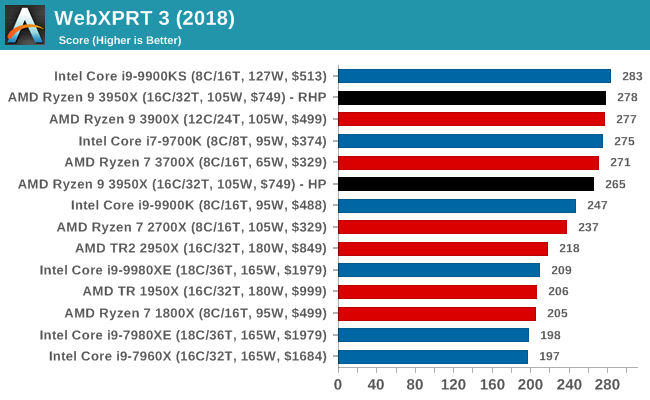
WebXPRT 2015: HTML5 and Javascript Web UX Testing
The older version of WebXPRT is the 2015 edition, which focuses on a slightly different set of web technologies and frameworks that are in use today. This is still a relevant test, especially for users interacting with not-the-latest web applications in the market, of which there are a lot. Web framework development is often very quick but with high turnover, meaning that frameworks are quickly developed, built-upon, used, and then developers move on to the next, and adjusting an application to a new framework is a difficult arduous task, especially with rapid development cycles. This leaves a lot of applications as ‘fixed-in-time’, and relevant to user experience for many years.
Similar to WebXPRT3, the main benchmark is a sectional run repeated seven times, with a final score. We repeat the whole thing four times, and average those final scores.
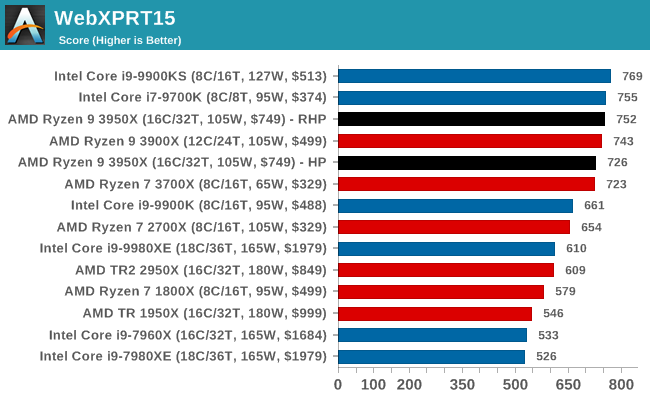
Speedometer 2: JavaScript Frameworks
Our newest web test is Speedometer 2, which is a accrued test over a series of javascript frameworks to do three simple things: built a list, enable each item in the list, and remove the list. All the frameworks implement the same visual cues, but obviously apply them from different coding angles.
Our test goes through the list of frameworks, and produces a final score indicative of ‘rpm’, one of the benchmarks internal metrics. We report this final score.
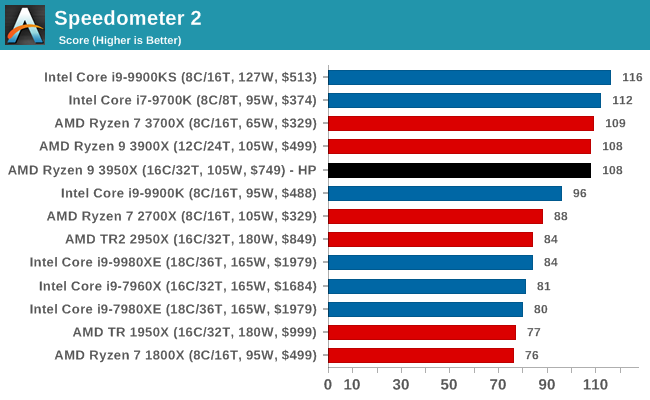
Google Octane 2.0: Core Web Compute
A popular web test for several years, but now no longer being updated, is Octane, developed by Google. Version 2.0 of the test performs the best part of two-dozen compute related tasks, such as regular expressions, cryptography, ray tracing, emulation, and Navier-Stokes physics calculations.
The test gives each sub-test a score and produces a geometric mean of the set as a final result. We run the full benchmark four times, and average the final results.

Mozilla Kraken 1.1: Core Web Compute
Even older than Octane is Kraken, this time developed by Mozilla. This is an older test that does similar computational mechanics, such as audio processing or image filtering. Kraken seems to produce a highly variable result depending on the browser version, as it is a test that is keenly optimized for.
The main benchmark runs through each of the sub-tests ten times and produces an average time to completion for each loop, given in milliseconds. We run the full benchmark four times and take an average of the time taken.

3DPM v1: Naïve Code Variant of 3DPM v2.1
The first legacy test in the suite is the first version of our 3DPM benchmark. This is the ultimate naïve version of the code, as if it was written by scientist with no knowledge of how computer hardware, compilers, or optimization works (which in fact, it was at the start). This represents a large body of scientific simulation out in the wild, where getting the answer is more important than it being fast (getting a result in 4 days is acceptable if it’s correct, rather than sending someone away for a year to learn to code and getting the result in 5 minutes).
In this version, the only real optimization was in the compiler flags (-O2, -fp:fast), compiling it in release mode, and enabling OpenMP in the main compute loops. The loops were not configured for function size, and one of the key slowdowns is false sharing in the cache. It also has long dependency chains based on the random number generation, which leads to relatively poor performance on specific compute microarchitectures.
3DPM v1 can be downloaded with our 3DPM v2 code here: 3DPMv2.1.rar (13.0 MB)
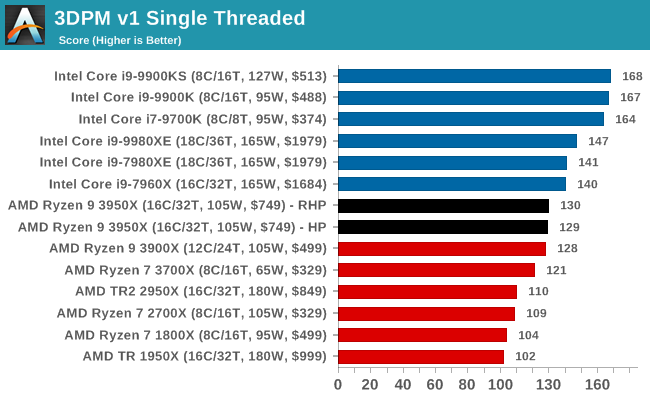
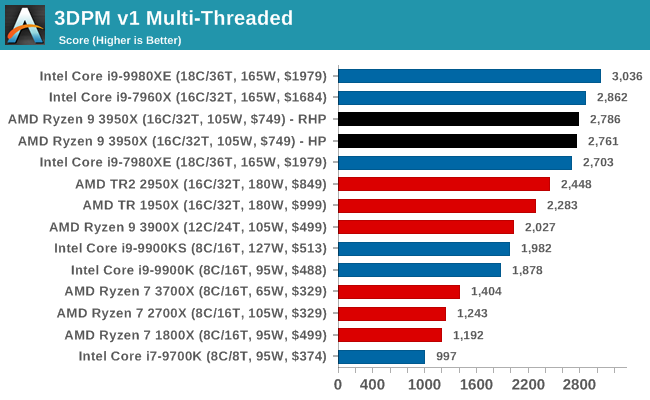
x264 HD 3.0: Older Transcode Test
This transcoding test is super old, and was used by Anand back in the day of Pentium 4 and Athlon II processors. Here a standardized 720p video is transcoded with a two-pass conversion, with the benchmark showing the frames-per-second of each pass. This benchmark is single-threaded, and between some micro-architectures we seem to actually hit an instructions-per-clock wall.
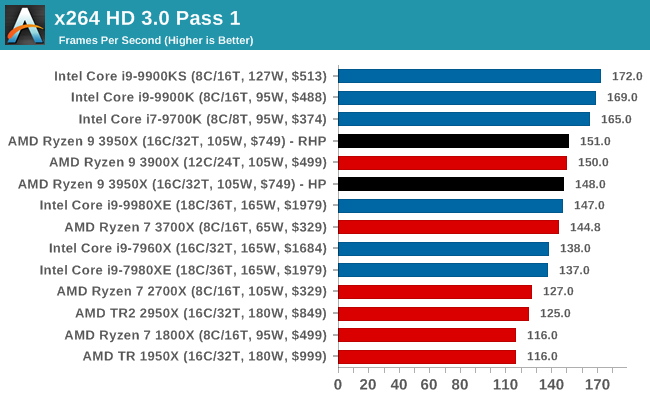
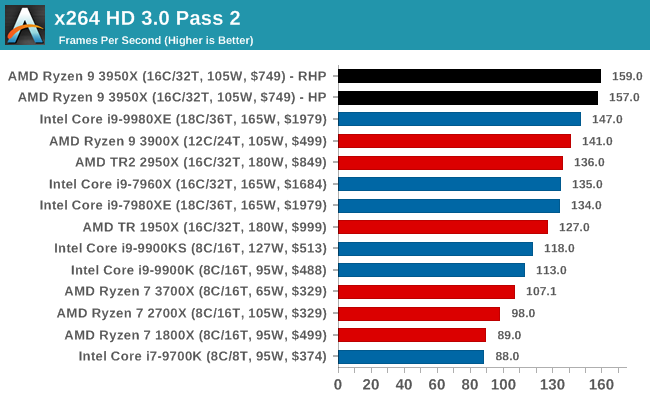
GeekBench4: Synthetics
A common tool for cross-platform testing between mobile, PC, and Mac, GeekBench 4 is an ultimate exercise in synthetic testing across a range of algorithms looking for peak throughput. Tests include encryption, compression, fast Fourier transform, memory operations, n-body physics, matrix operations, histogram manipulation, and HTML parsing.
I’m including this test due to popular demand, although the results do come across as overly synthetic, and a lot of users often put a lot of weight behind the test due to the fact that it is compiled across different platforms (although with different compilers).
We record the main subtest scores (Crypto, Integer, Floating Point, Memory) in our benchmark database, but for the review we post the overall single and multi-threaded results.

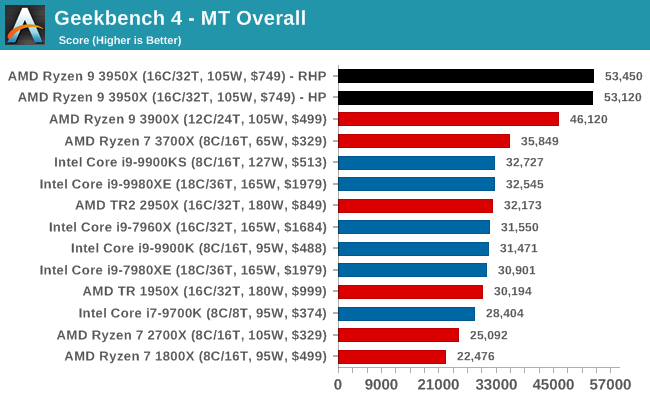










206 Comments
View All Comments
rocky12345 - Friday, November 15, 2019 - link
Great review thanks. I do have to nit pick though. You seem to be scolding AMD for the Zen 2 CPU's slightly going over the stated power limits. I found this a bit odd because of you look at Intel CPU's and how they sated their power limits. You will hardly ever see them coming even remotely close to the stated power limit because their CPU's under full load are pulling much more power than stated by Intel.Example the 9900K/9900KS have been seen pulling almost double the power as stated by Intel under stock conditions. Yes I understand AMD & Intel list their TDP power limits differently and on the Intel side those numbers mean very little unless you lock them at their base clocks without ever letting them go into turbo boost mode.
kc77 - Friday, November 15, 2019 - link
I noticed that as well. I'm noticing less and less TDP comparisons.ajlueke - Friday, November 15, 2019 - link
" the motherboard choice (as well as the cooling it uses) will matter."AMD has really been pushing the idea that VRMs and cooling will affect Ryzen 3000 series performance (likely to sell X570 motherboards), but I haven't come across any actual supporting data.
In my experience, the Ryzen 3000 series winds up voltage bound by FIT, well below excessive temperature or PPT, TDC, EDC bounds. Such that any additional headroom, like from a custom loop or better VRMs accomplishes nothing.
Now, the statement I quoted above is pretty definitive that it does matter. So I imagine, there is data supporting it. Care to share?
rickderick7 - Friday, November 15, 2019 - link
I bought AMD Ryzen 9 3950X last week, and set it up on my CPU , but since then my printer stopped working. Is that something related to this device? I even tried setting up the printer again with the below steps in the link, but still no luck. I need my printer working as before.Could someone advice on this?
Thanks
Rick
rickderick7 - Friday, November 15, 2019 - link
I bought AMD Ryzen 9 3950X last week, and set it up on my CPU , but since then my printer stopped working. Is that something related to this device? I even tried setting up the printer again with the below steps in the link, but still no luck. I need my printer working as before.https://123hp-com-setup.us/123hp-oj5255-wireless-s...
Could someone advice on this?
Thanks
Rick
Drazick - Saturday, November 16, 2019 - link
It has nothing to do with the CPU be it Intel or AMD.Supercell99 - Friday, November 15, 2019 - link
All these comments and I haven't read one useful one yet.Rudde - Friday, November 15, 2019 - link
It appears that AMD's PPT power limit is 35% higher than their TDP.Drazick - Saturday, November 16, 2019 - link
It is about time we move to Quad (4) Memory Channels in consumer computers.csell - Saturday, November 16, 2019 - link
Or DDR5 RAM. I expect the DDR5 RAMs to arrive first.